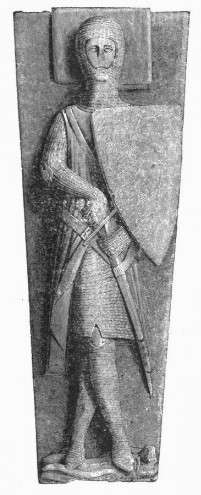William II Longespée


Sir William Longespée (c. 1212 – 8 February 1250) was an English knight and crusader, the son of William Longespée and Ela, Countess of Salisbury. His death became of significant importance to the English psyche, having died as a martyr due to the purported mistakes of the French at the Battle of Mansurah, near Al-Mansurah in Egypt.
Biography
Barons' Crusade

Longespée made two pilgrimages to the Holy Land. The first was as a participant in the second wave of crusaders of the Barons' Crusade. On 10 June 1240 he left England in the service of Richard, 1st Earl of Cornwall with roughly a dozen English barons and several hundred knights. They made their way to Marseilles in mid-September, and landed at Acre on 8 October. Longespée and Richard's men saw no combat there, but this group did complete the negotiations for a truce with Ayyubid leaders made by Theobald I of Navarre just a few months prior during the first wave of the crusade. They rebuilt Ascalon castle, and notably handed over custody of it to Walter Pennenpié, the imperial agent of Frederick II in Jerusalem (instead of turning it over to the local liege men of the Kingdom of Jerusalem who strongly opposed to Frederick's rule). On 13 April 1241 they exchanged Muslim prisoners with Christian captives who had been seized during Henry of Bar's disastrous raid at Gaza five months earlier. They also moved the remains of those killed in that battle and buried them at the cemetery in Ascalon. Longespée almost certainly departed with Richard for England on 3 May 1241.
Seventh Crusade
Longespée again made a pilgrimage to the Holy Land, this time in the Seventh Crusade of 1247. He proceeded to Rome and made a plea to Pope Innocent IV for support:
"Sir, you see that I am signed with the cross and am on my journey with the King of France to fight in this pilgrimage. My name is great and of note, viz., William Longespée, but my estate is slender, for the King of England, my kinsman and liege lord, hath bereft me of the title of earl and of that estate, but this he did judiciously, and not in displeasure, and by the impulse of his will; therefore I do not blame him for it. Howbeit, I am necessitated to have recourse to your holiness for favour, desiring your assistance in this distress. We see here (quoth he) that Earl Richard (of Cornwall) who, though he is not signed with the cross, yet, through the especial grace of your holiness, he hath got very much money from those who are signed, and therefore, I, who am signed and in want, do intreat the like favour."[1]
Having succeeded in gaining the favour of the Pope, Longespée raised a company of 200 English horse to join with King Louis on his crusade. To raise funds for his expedition, he sold a charter of liberties to the burgesses of the town of Poole in 1248 for 70 marks.[2] During the Seventh Crusade, Longespée commanded the English forces. He became widely known for his feats of chivalry and his subsequent martyrdom. The circumstances of his death served to fuel growing English animosity toward the French; it is reported that the French Count d'Artois lured Longespée into attacking the Mameluks before the forces of King Louis arrived in support. D'Artois, Longespée and his men, along with 280 Knights Templar, were killed at this time.
It is said that his mother, Countess Ela, had a vision of the martyr being received into heaven by angels on the day of his death. In 1252, the Sultan delivered Longespée's remains to a messenger who conveyed them to Acre for burial at the church of St Cross. However, his effigy is found amongst family members at Salisbury Cathedral, in England.
Marriage and issue
Longespée married Idoine de Camville, daughter of Richard de Camville and Eustacia Basset. They had three sons and a daughter:
- Ela Longespée, married James De Audley (1220–1272), of Heleigh Castle, Staffordshire, son of Henry De Audley and Bertred Mainwaring
- William III Longespée, married Maud de Clifford, granddaughter of Llewelyn ap Iorwerth, Prince of North Wales. Their daughter Margaret married Henry de Lacy, 3rd Earl of Lincoln.[3]
- Richard Longespée, married Alice le Rus, daughter of William le Rus of Suffolk and died shortly before 27 December 1261.[4]
- Edmund Longespée, The Book of Lacock names “Guill Lungespee tertium, Ric´um, Elam et Edmundum” as the children of “Guill Lungespee secundus” & his wife.
References
- ↑ Dodsworth, William (1814). An historical account of the episcopal see, and cathedral church, of Sarum, or Salisbury. Salisbury: Brodie and Dowding. pp. 192–193.
- ↑ "History Of Poole". Borough of Poole. 2009. Retrieved 2009-02-17.
- ↑ Alison Weir, Britain's Royal Family: A Complete Genealogy (London, U.K.: The Bodley Head, 1999), page 75.
- ↑ Richardson, Douglas (2005). Magna Carta Ancestry: A Study in Colonial and Medieval Families. Royal Ancestry Series. Baltimore, MD: Genealogical Publishing Company. p. 165. ISBN 0-8063-1759-0.
- The Times Kings & Queens of The British Isles, by Thomas Cussans (chart's 30 & 86) ISBN 0-00-714195-5
- Ancestral Roots of Certain American Colonists Who Came to America Before 1700 by Frederick Lewis Weis, Lines 30-27 and 122-30
External links
| Wikimedia Commons has media related to William II Longespée. |
Efigy in Salisbury cathedral long thought to be William Longspee is now identified as 14th century.